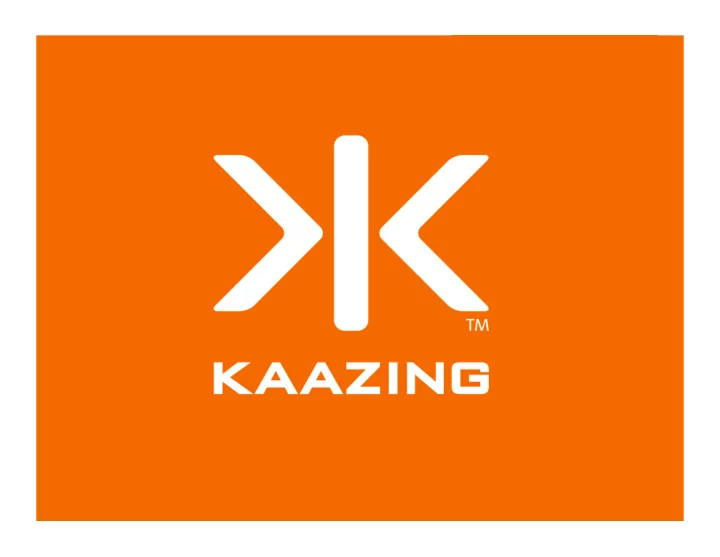

1
Breaking Barriers with HTML 5 Communication How to enable a stateful Web 2
Challenge “If we were not restricted by the traditional limitations of HTTP, what type of Web applications would we build?” 3
Speakers Jonas Jacobi Co-Founder: Kaazing Co-Author: Pro JSF and Ajax, Apress 4
Networking Review Desktop Networking Full-duplex bidirectional TCP sockets Access any server on the network Browser Networking Half-duplex HTTP request-response HTTP polling, long polling, streaming Same-origin HTTP requests 5
Defining Real-Time Web Or, is it just nearly, nearly real-time? 6
Push Technology Server-Initiated Message Delivery Clients are listening Clients behind firewalls Techniques such as Comet/Reverse Ajax Delays Completion of HTTP Response Generally Implemented in JS Scalability Limitations (Cost etc…) Not general purpose No standard 7
Half-duplex Architecture Java EE Container Chat Chat Server Client XMPP‐‐TCP (Full Duplex) HTTP Web Applica3on Logic (Half‐Duplex) Mail Server Mail Client Server IMAP‐‐TCP HTTP (Full Duplex) (Half‐Duplex) EJB JDBC EJB Database Client JDBC‐‐TCP RMI‐‐TCP HTTP (Full Duplex) (Full‐Duplex) (Half‐Duplex) Stock Stock JMS JMS JMS Trading Client HTTP JMS‐‐TCP JMS‐‐TCP Client (Half‐Duplex) (Full‐Duplex) (Full Duplex) Custom TCP (Full‐Duplex) Stock Server 8
W3C & IETF Work in Progress W3C HTML5 Specification (postMessage) Cross-Origin Resource Sharing EventSource API (Server-sent Events) WebSocket API IETF WebSocket Protocol (in conjunction with W3C WebSocket API spec) 9
HTML 5 postMessage Send Strings Between HTML Documents Documents may be served by different sites Standard API targetWindow.postMessage(message, targetOrigin) window.onmessage = function(event) { alert(event.data); } Browser Support IE 8, FF 3, Opera 9, Safari 4, Chrome 2 10
HTML 5 Server-Sent Events Standardizes and formalizes how a continuous stream of data can be sent from a server to a browser Introduces EventSource—a new JavaScript API 11
HTML 5 Server-Sent Events Connects to a server URL to receive an event stream: var stream = new EventSource("http://news.kaazing.com"); stream.onopen = function() { alert(“open”); } stream.onmessage = function(event) { alert(“message: “ + event.data); } stream.onerror = function() { alert(“error”); } 12
HTML 5 Server-Sent Events Server can add the id event property so that clients can add a Last-Event-ID header during reconnect Used to guarantee message delivery Server can specify an optional retry header as part of an event in the event stream 13
Cross-Site Resource Sharing W3C Technical Report Access control for client-side cross-origin requests Published Sept 12, 2008 http://www.w3.org/TR/access-control/ Browser Support Firefox 3.5 IE8 XDomainRequest (similar) Opera, Safari, Chrome coming 14
Cross-Site Resource Sharing GET / HTTP/1.1\r\n Host: www.w3.org\r\n Origin: http://www.kaazing.com\r\n … \r\n 200 OK HTTP/1.1\r\n Allow-Origin: http://www.kaazing.com\r\n … \r\n 15
16
WebSockets W3C Specification – WebSocket API http://dev.w3.org/html5/websockets/ HTTP-friendly TCP for the browser Full-duplex bidirectional communication Operates over a single socket Browser Support (coming) Webkit – Bug 28844 Firefox – Bug 472529 17
WebSockets Distributed client-server architecture No browser plug-ins Traverses proxies and firewalls seamlessly HTTP CONNECT Allows authorized cross-origin communication Share port with existing HTTP content at different path 18
WebSockets Connection established by upgrading from the HTTP protocol to the WebSocket protocol WebSocket data frames can be sent back and forth between the client and the server in full-duplex mode 19
WebSockets Supports a diverse set of clients Cannot deliver raw binary data to JavaScript Binary data is ignored if the client is JavaScript 20
WebSocket Schemes ws://www.websocket.org/text wss://www.websocket.org/encrypted-text 21
WebSocket Handshake GET /text HTTP/1.1\r\n Upgrade: WebSocket\r\n Connection: Upgrade\r\n Host: www.websocket.org\r\n …\r\n HTTP/1.1 101 WebSocket Protocol Handshake\r\n Upgrade: WebSocket\r\n Connection: Upgrade\r\n …\r\n 22
WebSocket Frames Frames can be sent full-duplex Either direction at any time Text Frames use terminator \x80Hello, WebSocket\0xff Binary Frames use length prefix \x00\0x10Hello, WebSocket Text and binary frames on same WebSocket 23
WebSockets API Creating a WebSocket instance: var myWebSocket = new WebSocket (“ws://www.websocket.org”); 24
WebSockets API Associating listeners: myWebSocket.onopen = function(evt) { alert(“Connection open ...”); }; myWebSocket.onmessage = function(evt) { alert( “Received Message: ” + evt.data); }; myWebSocket.onclose = function(evt) { alert(“Connection closed.”); }; 25
WebSockets API Sending messages: myWebSocket.postMessage(“Hello WebSocket!”); myWebSocket.disconnect(); 26
Extending WebSockets Any TCP-based Protocol Works on WebSocket JMS, AMQP, STOMP, XMPP, IMAP, AMQP, IRC, … Custom Protocols Binary Protocols Encode Binary as Text 27
WebSocket Security HTTP Security 401 Not Authorized Cross-domain communication Secure WebSockets wss ://www.websocket.org SSL just like HTTPS Single Sign-on HTTP credentials vs. protocol credentials Protocol Attacks Validate protocol syntax and semantics 28
Stomp Client Example var myStomp = new StompClient(); myStomp.onopen = function(headers) { myStomp.subscribe(“/topic/destination”); } myStomp.onmessage = function(headers, body) { alert(body); } myStomp.connect(“ws://www.websocket.org/stomp”); myStomp.send(“Hello STOMP!”, “/topic/destination”); 29
Full-duplex Architecture XMPP ‐‐TCP (Full‐Duplex) Chat Server >|< Websocket Gateway TCP over HTTP (Full‐Duplex) Messaging JMS ‐‐TCP (Full‐Duplex) System TCP over HTTP Java EE (Full‐Duplex) JDBC JDBC‐‐TCP (Full‐Duplex) RMI‐‐TCP (Full‐Duplex) EJB Database TCP over HTTP (Full‐Duplex) Trading Custom‐‐TCP (Full‐Duplex) System TCP over HTTP (Full‐Duplex) 30
31
Stateful Asynchronous System News Feed Trading System Payment System Web Websocket Gateway Client Database / Internet Storage Web Messaging System Client Application Logic Desktop/ Web Server Services ERP/CRM Desktop System Solution 32
Summary HTML 5 Communication has arrived (early) W3C WebSockets will change everything Open your mind and be creative 33
34
Coming soon to a bookstore … 35
Recommend
More recommend